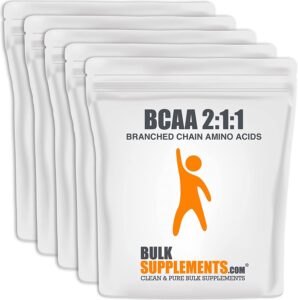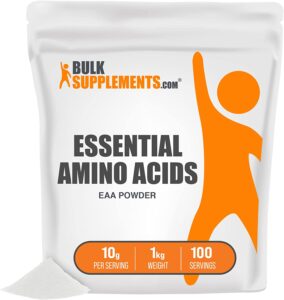 How To Build More Muscle With Nutrition: The Battle of EAAs vs BCAAs
How To Build More Muscle With Nutrition: The Battle of EAAs vs BCAAs
Poke around the internet and it gets confusing in the land of endless supplements. Here is a question I received the other day:
“Hey doc, I heard that BCAAs are not useful at all for adding muscle. Is this true? Thanks,” – Mark
If you are old like me, you remember back to the stone age when branch chain amino acids (BCAAs) were all the rage. They were in pre-workouts, intra-workouts, and post-workout supplements. The rationale was that they could be substituted for protein and help you build more muscle. Is that really true based on new data though? Are BCAAs really that useful to add new muscle? Before we can answer that, let’s back up and review the 3 key nutrition factors to add new muscle then tackle the BCAA question.
Muscle Assembly Line: Building Muscle
Step 1: Think of the muscle building process as running an assembly line to the land of mo’ muscle.
Once you have the assembly line all ready to go, you need to of course turn it on! In terms of muscle, the key is the amino acid leucine. Leucine is the main trigger to turn on the process of muscle protein synthesis (MPS / our muscle building assembly line). The next question then is- how much? From research, the dose clocks in at around 2-3 grams at once (1-3).
Step 1 = 2-3 gram of leucine.
Step 2: When you are running the assembly line, you need raw materials in order to build things.
For muscle building your body needs new amino acids to shove into muscle tissue. Amino acids are the smaller components found in dietary protein. While you can eat whole proteins for sure, your body primarily only uses a few of these amino acids in the muscle building process. These are called essential amino acids (EAAs). EAAs serve as the building blocks to muscle tissue. This is where BCAAs fall short; they do not have all the EAAs. The minimum you need based on research is 6 grams of EAAs (4-5).
Step 3: You need energy to run the assembly line.
In your body for energy, you may be able to divert some from stored fat, and glucose (stored in the liver and muscle as glycogen), but if you want to maximize this muscling building process, you will need to be in a calorie surplus. How much of a surplus is up for debate and is another article in itself, but around an extra 500 kcal is a good start. My bias is for those extra calories to be in the form of carbohydrates as they are the main fuel for picking stuff of the ground, putting it over your head and all other forms of weight training.
No Use Ever for BCAAs?
While BCAAs by themselves are inferior to EAAs and whole protein for building new muscle, BCAAs can serve as a way to bump up the quality of lower-level proteins (most vegan proteins). Vegan proteins tend to short in leucine and BCAAs do include leucine.
In practice, if you are having a plant / vegan based meal that is less than about 20-30 grams of total protein, add 2-4 grams of BCAAs or just the amino acid leucine at around 2 grams to your meal.
 EAAs vs Whole Protein
EAAs vs Whole Protein
Another advantage of EAAs is you can take them right before training when you are worried that protein may not sit well /result in digestion issues. No need to crop dust the entire gym.
If you are on a budget and want to use EAAs – you can get them as raw EAAs from Bulk Supplements. Warning*- they do smell bad and you will want to mix them with crystal-light or something to flavor them. Another trick is to squeeze a lemon or 2 limes in with them as the slight acid will allow them to mix better too. EAAs by themselves are hydrophobic and don’t want to go into solution very well. The benefit is that you can save a ton of money by doing this over pre-packaged EAAs.
Conclusion
Just some of my nerdy nutrition facts for more muscle! If your interest has been sparked to try EAA’s or BCAA’s head over to the Bulk Supplements site and use code drmike for 5% off your entire order!
Much love,
Dr. Mike T Nelson
PhD, MSME, CISSN, CSCS
Carrick Institute Associate Professor


 How To Build More Muscle With Nutrition: The Battle of EAAs vs BCAAs
How To Build More Muscle With Nutrition: The Battle of EAAs vs BCAAs EAAs vs Whole Protein
EAAs vs Whole Protein